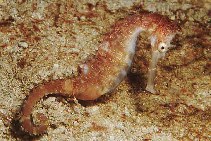| Family: |
Syngnathidae (Pipefishes and seahorses), subfamily: Syngnathinae |
| Max. size: |
17 cm TL (male/unsexed) |
| Environment: |
reef-associated; marine; depth range 0 - 82 m, non-migratory |
| Distribution: |
Indo-Pacific: South Africa to French Polynesia; north to Japan, south to Australia. Not in the Red Sea. |
| Diagnosis: |
Dorsal spines (total): 0-0; Dorsal soft rays (total): 15-18; Anal spines: 0-0; Anal soft rays: 4-4. Description: (based on 22 specimens): Adult height: 7.9-13.5cm. Rings: 11 + 35 (34-37). Snout length: 1.7-2.0 in head length. Dorsal fin rays: 17 (15-18) covering 2+1 rings. Pectoral fin rays: 18 (17-20). Coronet: medium, with four or five very long, very sharp spines. Spines: extremely long and sharp; all spines well-developed. Other distinctive characters: very long snout (more than 1/2 head length); single cheek spine; dorsal fin base very short; always has at least as many pectoral as dorsal fin rays (whereas most species have more dorsal fin rays); sharp ventral keel; prominent spine in front of coronet.
Color pattern: base color variable, including pale pink, yellow or green; spines often dark tipped; may have pale ‘saddles’, often filled with small dark spots, across dorsolateral surfaces; snout not striped. |
| Biology: |
A rare inhabitant of shallow sheltered reefs, found among clumps of algae or in seagrass beds. Large adult pelagic and probably associated with drifting debris. Associated with sponges and sea-squirts (Ref. 30915, 58302). Ovoviviparous (Ref. 205). Feeds on zooplanktons and small crustaceans (Ref. 89972). The male carries the eggs in a brood pouch which is found under the tail (Ref. 205). Use in traditional Chinese medicine is increasing with the rise in patent medicines (Ref. 30915). Not common in the aquarium trade (Ref. 30915). Minimum depth reported taken from Ref. 128812. |
| IUCN Red List Status: |
Vulnerable (VU); Date assessed: 26 January 2017 (A2cd+4cd) Ref. (130435)
|
| Threat to humans: |
harmless |
Source and more info: www.fishbase.org. For personal, classroom, and other internal use only. Not for publication.

